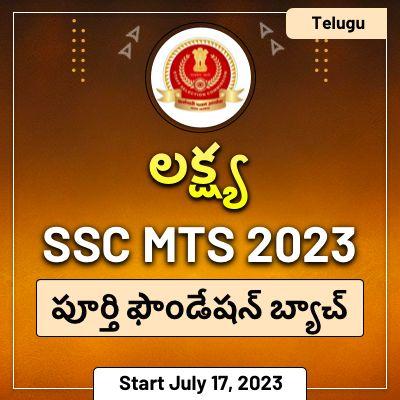
ఆంధ్రప్రదేశ్ మరియు తెలంగాణ లో అత్యంత ముఖ్యమైన మరియు ప్రతిష్టాత్మకమైన పరీక్షలు గ్రూప్-1,2,3 అలాగే UPSC లలోనికి చాలా మంది ఆశావహులు ఈ ప్రతిష్టాత్మక ఉద్యోగాల్లో కి ప్రవేశించడానికి ఆసక్తి చూపుతారు.దీనికి పోటీ ఎక్కువగా ఉండడం కారణంగా, అధిక వెయిటేజీ సంబంధిత సబ్జెక్టులను ఎంచుకుని స్మార్ట్ అధ్యయనంతో ఉద్యోగం పొందవచ్చు. ఈ పరీక్షలలో ముఖ్యమైన అంశాలు అయిన పౌర శాస్త్రం , చరిత్ర , భూగోళశాస్త్రం, ఆర్ధిక శాస్త్రం, సైన్సు మరియు విజ్ఞానం, సమకాలీన అంశాలు చాల ముఖ్యమైన పాత్ర పోషిస్తాయి. కాబట్టి Adda247, ఈ అంశాలకి సంబంధించిన కొన్ని ముఖ్యమైన ప్రశ్నలను మీకు ప్రతిరోజు క్విజ్ రూపంలో అందిస్తుంది. ఈ పరీక్షలపై ఆసక్తి ఉన్న అభ్యర్థులు దిగువ ఉన్న ప్రశ్నలను పరిశీలించండి.
ప్రశ్నలు
Q1. ఆక్సేలా- చాపెల్ సంధి ఈ సమయంలో ముగిసింది:
(a) మొదటి కర్ణాటక యుద్ధం
(b) మూడవ ఆంగ్లో-మైసూరు యుద్ధం
(c) ఆంగ్లో-డచ్ యుద్ధం
(d) మూడవ కర్ణాటక యుద్ధం
Q2. ఈ క్రింది వాటిలో భారతదేశానికి తగిన సమయంలో ఆధిపత్య హోదాను ఇవ్వడానికి “దీపావళి ప్రకటన” జారీ చేసింది ఎవరు?
(a) క్రిప్స్ మిషన్
(b) వైస్రాయ్ ఇర్విన్
(c) వైస్రాయ్ మౌంట్ బాటన్
(d) సైమన్ కమిషన్
Q3. షేర్ షా సూరికి సంబంధించి దిగువ ప్రకటనలను పరిగణనలోకి తీసుకోండి,
- అతడు రాజ్యాన్ని ఎనిమిది తరఫ్ లుగా విభజించాడు, ఒక్కొక్కటి ఒక తరాఫ్దార్ చేత పాలించబడింది.
- స్థానిక నేరాలకు స్థానిక బాధ్యత అనే సూత్రాన్ని ఆయన ప్రవేశపెట్టారు మరియు క్రిమినల్ మరియు సివిల్ కేసులను విడిగా పరిష్కరించారు.
పైన ఇవ్వబడ్డ ప్రకటనల్లో ఏది సరైనది?
(a) 1 మాత్రమే
(b) 2 మాత్రమే
(c) 1 మరియు 2 రెండూ
(d) 1, 2 కాదు
Q4. భారతదేశ మధ్యయుగ చరిత్రలో దహ్సాలా వ్యవస్థ గా పిలువబడే ఒక వ్యవస్థ ఎవరి పాలనలో ప్రవేశపెట్టబడింది-
(a) అక్బర్
(b) షేర్ షా సూరి
(c) జహంగీర్
(d) ఔరంగజేబు
Q5. “ఢిల్లీ చలో ఉద్యమం” ఈ క్రింది వాటిలో దేనితో సంబంధం కలిగి ఉంది?
(a) ధరాసన సత్యాగ్రహం
(b) వ్యక్తిగత సత్యాగ్రహం
(c) సహకారేతర ఉద్యమం
(d) శాసనోల్లంఘన ఉద్యమం
Q6. హర్ష రాజ్యానికి సంబంధించిన ఈ క్రింది ప్రకటనలను పరిశీలించండి
- పరిపాలన యొక్క స్వభావం పూర్తిగా కేంద్రీకృతం చేయబడింది.
- ఆయన కాలంలో మంత్రులు, ఉన్నతాధికారులకు వారి సేవలకు నగదు రూపంలో మాత్రమే చెల్లించేవారు.
పైన ఇవ్వబడ్డ ప్రకటనల్లో ఏది సరైనది?
(a) 1 మాత్రమే
(b) 2 మాత్రమే
(c) 1 మరియు 2 రెండూ
(d) 1, 2 కాదు
Q7. హర్షచరితను ఎవరు రాశారు?
(a) బనాభట్ట
(b) కల్హానా
(c) అల్ బరౌనీ
(d) పైన పేర్కొన్నవేవీ కావు
Q8. దిగువ జతలను పరిగణనలోకి తీసుకోండి.
- రాజతరంగిని : కల్హానా
- మాళ్వికాగ్నిమిత్రము : హరీసెన
- మృచ్ఛకటిక : సుద్రక
పైన ఇవ్వబడ్డ జత/ల్లో ఏది సరైనది?
(a) 1 మరియు 3
(b) 2 మాత్రమే
(c) 3 మాత్రమే
(d) 1 మరియు 2
Q9. సన్యాసి తిరుగుబాటు అనగా 18వ శతాబ్దం చివరిలో ఈస్ట్ ఇండియా కంపెనీ పాలనకు వ్యతిరేకంగా సన్యాసి, ఫకీర్లు (హిందూ, ముస్లిం సన్యాసిలు) చేసిన తిరుగుబాట్లు ఇవి ప్రాంతానికి చెందినవి..
(a) బెంగాల్
(b) చిత్తోర్
(c) అవధ్
(d) ఒడిషా (ఒరిస్సా)
Q10. బౌద్ధ సంప్రదాయంలో మహిళలకు అధికారం ఇవ్వాలి కోరిన మొదటి మహిళ ఎవరు?
(a) యశోధర
(b) మహాపజాపతి గోతమి
(c) సుజాత
(d) ధమ్మానంద
ఆన్లైన్ లైవ్ క్లాసుల కొరకు ఇక్కడ క్లిక్ చేయండి
జవాబులు
S1.Ans.(a)
Sol.The First Carnatic War (1744-48) was triggered by the War of the Austrian Succession, and saw the French win a series of victories over their English rivals in
the south of India, although the pre-war situation was restored by the Treaty of Aix-le- Chapelle.
- Under the terms of this treaty, Madras was handed back to the English, and the French, in turn, got their territories in North America. All conquered lands were restored except for Silesia, which was kept by Prussia, and Parma, Piacenza, and Guastalla, kept by Spain.
S2.Ans.(b)
Sol.Deepavali Declaration (1929): It is a declaration that would grant India dominion status in due course. It was Issued by Lord Irwin.
Lord Irwin (1926-31):
Appointment of the Indian States Commission under Butler (1927) to recommend measures for the establishment of better relations between the Indian states and the Central government.
Royal Commission on Indian Labour was appointed (1929), Report (1931).
Sarda Act was passed in 1929 Marriages of girl below 14 and boys below 18 years of age was prohibited.
S3.Ans.(b)
Sol.Statement 1 is incorrect –Tarafdari was a system in the reign of Mahmud Gawan of the Bahmani Kingdom. Under Suri’s administration – For administrative convenience, the whole empire was divided into forty-seven units (Sarkars), each of which was again subdivided into several Parganas. The pargana has one Amin, one Shiqdar, and one treasurer to keep accounts. The next higher administrative unit i.e. over the sarkar, were placed a Shiqdar-i-Shiqdaran and a Munsif-i-Munsifan to supervise the work of the pargana officers.
Statement 2 is correct – Sher Shah has a strong sense of justice and no distinctions were made between the high and the low. In the paragana / pargana, civil suits were disposed off by the Amin, and other cases mostly criminal by the Qazi and Mir-i-Adal.
In some Parganas, civil cases were tried by Munsif-i-Munsifan. At the capital city there were the chief Qazi, the imperial Sadr, and above all, the Emperor as the highest authority in judicial as in other matters.
S4.Ans.(a)
Sol.Todar Mal had developed his expertise in Sher Shah’s employ but the full extent of this system was introduced in the regime of the emperor Akbar, where he joined the service as a clerk AND LATER MADE A ‘WAZIR’. He reconstructed the land tax structure and introduced compensation for crop damage. His systems were so effective and modem that the others and even the British followed it later on. In 1582 Akbar bestowed on Raja Todar Mai the title Diwan-I- Ashraf. He was one of the ‘Navratnas’ of Akbar’s courts.
S5.Ans.(b)
Sol.In 1940, then Viceroy Linlithgow made a set of proposals called the ‘August offer’ which included that a representative Indian body would frame a constitution for India after the war, and Dominion status is the objective for India. Indian National Congress rejected this offer in its meeting at Wardha in August 1940 and demanded complete freedom from colonial rule. Jawaharlal Nehru remarked that the dominion status concept was as dead as a doornail. After this, Mahatma Gandhi initiated the Individual Satyagraha to affirm the right to free speech. He avoided a mass satyagraha because he did not want violence. The first three Satyagrahis were Vinoba Bhave, Nehru, and Brahma Datt. All three were jailed. The Satyagrahis also started a march towards Delhi which was called the ‘Delhi Chalo Movement’ but the movement failed to pick up steam and was suspended in December 1940.
- Hence option (b) is the correct answer.
S6.Ans.(d)
Sol.After the Gupta’s time, the entire north India was split up into several kingdoms and the reign was passed in the hands of half a dozen feudatories. Gradually one of these dynasties ruling at Thanesar in Haryana extended its authority over all other feudatories. The ruler who brought it was Harsha Vardhan. He made Kanauj the seat of his power. Chinese traveler Hiuen Tsang’s account gives an important insight into the state of his administration.
- His administration was feudal and decentralized in nature. Land grants to the priestly class, a practice of Gupta’s time was continued. In addition to this practice, grants of land were also offered to the high officials and ministers. The revenue during his time was divided into four parts. one part was earmarked for the expenditure of the King, second for scholars, third for the endowment of official and public servant, and fourth for religious purposes.
- In his empire, law, and order were not well maintained. The roads and river routes were not completely immune from robbery. Hiuen Tsang, about whom special care was taken by the government was robbed of his belongings. Severe punishments used to be inflicted on the crime. The robbery was considered to be second treason for which the right hand of the robber was amputated. But, under the influence of Buddhism, the severity of punishment was reduced.
S7.Ans.(a)
Sol.Banabhatta also gave an account of the early years of Harsha’s rule in his book Harshacharitra.
S8.Ans.(a)
Sol.Pair 1 is correctly matched: Rajatarangini is a metrical legendary and historical chronicle of the north- western Indian subcontinent, particularly the kings of Kashmir. It was written in Sanskrit by Kashmiri historian Kalhana in the 12th century CE. The work consists of 7826 verses, which are divided into eight books called Tarangas. books called Tarangas.
- Pair 2 is not correctly matched: Kalidasa’s Malavikagnimitram is based on some events of the reign of Pushyamitra Shunga. The Sanskrit play depicts Agnimitra as its hero. Malvika is a maid servant whom Agnimitra falls in love with. This was known to his chief queen, who imprisons her. Later it was known that Malvika was of royal birth and she was accepted as queen of Agnimitra. Malavikagnimitram gives an account of Rajsuya Yajna of Pushyamitra Shunga, father of Agnimitra.
- Pair 3 is correctly matched: Mrichchhakatika (The Little Clay Cart) is a ten-act Sanskrit drama attributed to Sudraka. The play is set in the ancient city of Ujjayini during the reign of King Pālaka, near the end of the Pradyota dynasty that made up the first quarter of the fifth century BC. The central story is that of noble but impoverished young Brahmin, Charudatta, who falls in love with a wealthy courtesan or nagarvadhu, Vasantasena.
S9.Ans.(a)
Sol.It is also known as the Sannyasi rebellion which took place around the Murshidabad and Baikunthupur forests of Jalpaiguri (now in West Bengal). Historians have not only debated what events constitute the rebellion but have also varied on the significance of the rebellion in Indian history.
While some refer to it as an early war for India’s independence from foreign rule, since the right to collect tax had been given to the British East India Company after the Battle of Buxar in 1764,others categorize it as acts of violent banditry following the depopulation of the province in the Bengal famine of 1770.
S10.Ans.(b)
Sol.Mahāpajāpatī Gotamī was the step-mother and maternal aunt (mother’s sister) of the Buddha. In the Buddhist tradition, she was the first woman to seek ordination for women, which she did from Gautama Buddha directly, and she became the first bhikkhuni (Buddhist nun). When King Suddhodhana, died, Mahapajapati Gotami decided to attain ordination. Mahapajapati Gotami went to the Buddha and asked to be ordained into the Sangha. The Buddha refused initially but later agreed on the condition that women nuns must follow the eight gurudhammas or conditions laid down by him to be a part of the sangha. Gotami agreed to accept the Eight Garudhammas and was accorded the status of the first bhikkhuni. Subsequent women had to undergo full ordination to become nuns
ఆన్లైన్ లైవ్ క్లాసుల కొరకు ఇక్కడ క్లిక్ చేయండి
ఆంధ్ర ప్రదేశ్ జాగ్రఫీ మరియు వీక్లీ కరెంటు అఫైర్స్ డౌన్లోడ్ చేసుకొనుటకు ఇక్కడ క్లిక్ చేయండి
11 మే 2021 యొక్క కరెంటు అఫైర్స్ కొరకు ఇక్కడ క్లిక్ చేయండి
11 మే 2021 యొక్క కరెంటు అఫైర్స్ క్విజ్ కొరకు ఇక్కడ క్లిక్ చేయండి












